Zimbabwe and Botswana, Africa
In January of 1996, I went to southern Africa with my friend Amy Smith, where we spent almost a month visiting the countries of Zimbabwe and Botswana. We spent most of our time in Zimbabwe, starting in the city of Bulawayo. Nearby are the Matobo National Park and Tshabalala Game Sanctuary, where we saw much wildlife. Also nearby are the Khami Ruins, the remnants of a 17th century civilization.
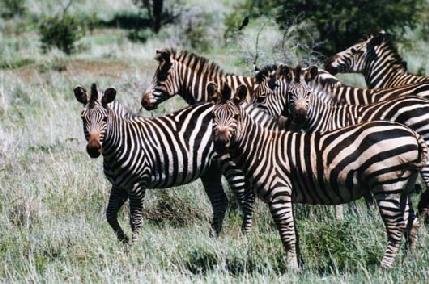
This photo was taken in the Tshabalala Game Sanctuary about 10 km south of Bulawayo. Tshabalala is unique in that we could roam the park on foot or on bicycle since there are no large predators in the sanctuary. It's a lot more fun to see wildlife this way because it actually feels like we're tracking animals in the wild rather than if we were being driven around in a jeep. We spotted these zebra and approached them on foot getting to within 25 yards before they would retreat. They would not retreat far, but always kept a safe distance of about 25 to 30 yards.
 From there we went on to Hwange National Park, Zimbabwe's largest national park. Most of the park is totally wild and is inaccessible to the casual traveler. However, there is plenty to see in the parts of the park that have paved roads and are easily accessible. We saw giraffe, zebra, elephant, jackal, impala, kudu, wildebeest, lion, and others. Some of the birds we saw were the lilac breasted roller, crimson breasted shrike, paradise whydah, and the cori bustard.
From there we went on to Hwange National Park, Zimbabwe's largest national park. Most of the park is totally wild and is inaccessible to the casual traveler. However, there is plenty to see in the parts of the park that have paved roads and are easily accessible. We saw giraffe, zebra, elephant, jackal, impala, kudu, wildebeest, lion, and others. Some of the birds we saw were the lilac breasted roller, crimson breasted shrike, paradise whydah, and the cori bustard.

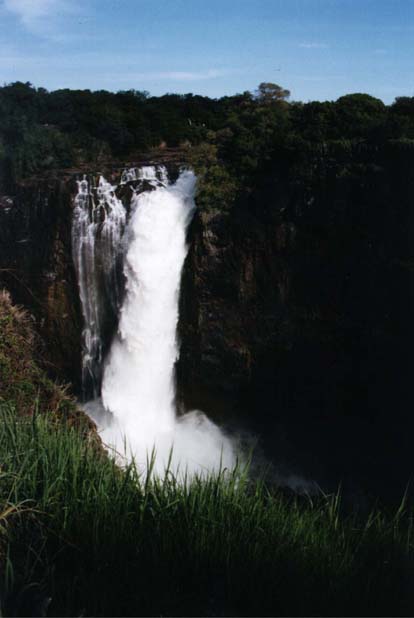 Nearby is the world famous Victoria Falls. At left is the Devil's Cataract, on the western part of the falls. The Zambezi River which forms the border between Zimbabwe and Zambia fans out to a width of over 1 mile before it plunges 300 feet into a gorge. Whitewater rafting trips, run by numerous companies, begin just below the falls. There are about 30 rapids in a 25 km stretch with numerous class IV and class V rapids as well as a commercially unraftable class VI. We had to walk our rafts around that one. Even though there are some stretches of calm water where we had to paddle, the scenery is so beautiful that it didn't matter. The Zambezi flows in a deep gorge with rocky cliffs rising about 300 feet straight up from the riverbank.
Nearby is the world famous Victoria Falls. At left is the Devil's Cataract, on the western part of the falls. The Zambezi River which forms the border between Zimbabwe and Zambia fans out to a width of over 1 mile before it plunges 300 feet into a gorge. Whitewater rafting trips, run by numerous companies, begin just below the falls. There are about 30 rapids in a 25 km stretch with numerous class IV and class V rapids as well as a commercially unraftable class VI. We had to walk our rafts around that one. Even though there are some stretches of calm water where we had to paddle, the scenery is so beautiful that it didn't matter. The Zambezi flows in a deep gorge with rocky cliffs rising about 300 feet straight up from the riverbank.
 Before the trip the guides warned us not to succumb to the temptation of swimming in the calm sections of the river because of crocodiles. And sure enough, we saw a young croc sunning itself on the shore. Fortunately, they don't venture into the whitewater sections of the river, where we were more likely to get tossed overboard. In the photo at right, I am the third from the left and Amy is the third from the right.
Before the trip the guides warned us not to succumb to the temptation of swimming in the calm sections of the river because of crocodiles. And sure enough, we saw a young croc sunning itself on the shore. Fortunately, they don't venture into the whitewater sections of the river, where we were more likely to get tossed overboard. In the photo at right, I am the third from the left and Amy is the third from the right.
It's not far from there to Botswana where we spent a few days in and around Chobe National Park. Chobe National Park was quite different from Hwange. Chobe had a wilder feel as its roads were unpaved and less crowded. It therefore had less of a feeling of being in a zoo. That may have been partly because we were touring in the back of an open pickup truck (thanks to the hospitality of two South African fellows) as opposed to the fancy jeeps used by the game drive companies. This also allowed us to spend the entire day in the park instead of the standard two hour game drive offered by the guides.
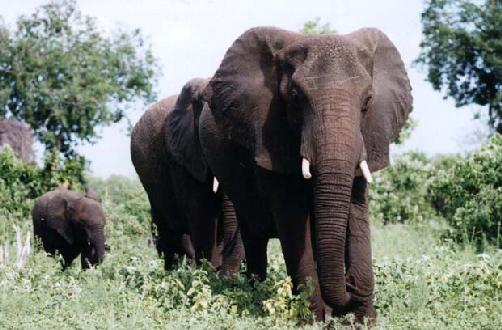
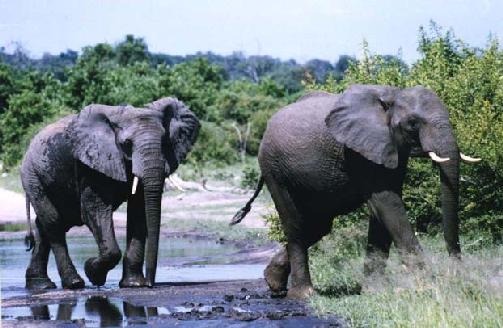
Chobe is famous for its elephant population. It is actually difficult to spend any significant time in the park without coming across some elephants. This is true even in the rainy season when they are supposedly dispersed widely throughout the park.
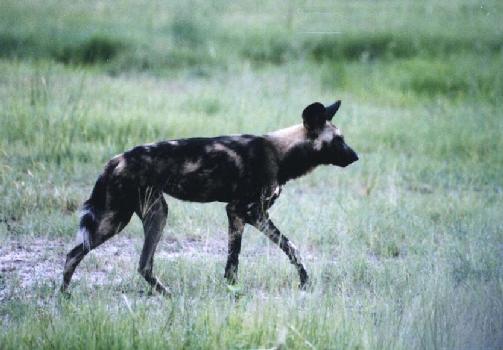
One of the rarest sights in all of Africa is that of a lone African Wild Dog. We were fortunate enough to see one in Chobe. Wild dogs are pretty rare and when spotted are almost always in a pack. We saw this one trot across a clearing and approach some kudu and impala in what looked to be a half hearted attempt at a hunt.
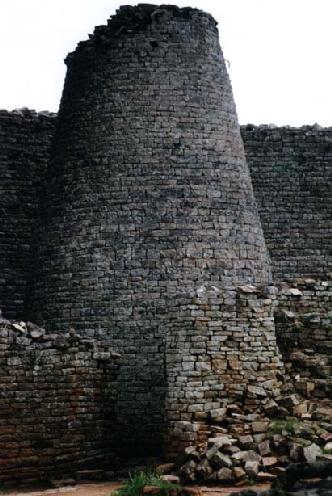
Back in Zimbabwe, our final stop was the town of Masvingo and the ruins of Great Zimbabwe. Great Zimbabwe was a flourishing civilization in the 12th through 14th centuries AD, ruled by the Mwenemutapa. Its principal trade item was gold, which it exported out to the Swahili civilizations of the East African coast. The ruins consist of two main areas, the Great Enclosure and the Hill Ruins. It is believed that these stone structures served as living quarters for the elite and also as religious centers.


 From there we went on to Hwange National Park, Zimbabwe's largest national park. Most of the park is totally wild and is inaccessible to the casual traveler. However, there is plenty to see in the parts of the park that have paved roads and are easily accessible. We saw giraffe, zebra, elephant, jackal, impala, kudu, wildebeest, lion, and others. Some of the birds we saw were the lilac breasted roller, crimson breasted shrike, paradise whydah, and the cori bustard.
From there we went on to Hwange National Park, Zimbabwe's largest national park. Most of the park is totally wild and is inaccessible to the casual traveler. However, there is plenty to see in the parts of the park that have paved roads and are easily accessible. We saw giraffe, zebra, elephant, jackal, impala, kudu, wildebeest, lion, and others. Some of the birds we saw were the lilac breasted roller, crimson breasted shrike, paradise whydah, and the cori bustard.

 Nearby is the world famous Victoria Falls. At left is the Devil's Cataract, on the western part of the falls. The Zambezi River which forms the border between Zimbabwe and Zambia fans out to a width of over 1 mile before it plunges 300 feet into a gorge. Whitewater rafting trips, run by numerous companies, begin just below the falls. There are about 30 rapids in a 25 km stretch with numerous class IV and class V rapids as well as a commercially unraftable class VI. We had to walk our rafts around that one. Even though there are some stretches of calm water where we had to paddle, the scenery is so beautiful that it didn't matter. The Zambezi flows in a deep gorge with rocky cliffs rising about 300 feet straight up from the riverbank.
Nearby is the world famous Victoria Falls. At left is the Devil's Cataract, on the western part of the falls. The Zambezi River which forms the border between Zimbabwe and Zambia fans out to a width of over 1 mile before it plunges 300 feet into a gorge. Whitewater rafting trips, run by numerous companies, begin just below the falls. There are about 30 rapids in a 25 km stretch with numerous class IV and class V rapids as well as a commercially unraftable class VI. We had to walk our rafts around that one. Even though there are some stretches of calm water where we had to paddle, the scenery is so beautiful that it didn't matter. The Zambezi flows in a deep gorge with rocky cliffs rising about 300 feet straight up from the riverbank.  Before the trip the guides warned us not to succumb to the temptation of swimming in the calm sections of the river because of crocodiles. And sure enough, we saw a young croc sunning itself on the shore. Fortunately, they don't venture into the whitewater sections of the river, where we were more likely to get tossed overboard. In the photo at right, I am the third from the left and Amy is the third from the right.
Before the trip the guides warned us not to succumb to the temptation of swimming in the calm sections of the river because of crocodiles. And sure enough, we saw a young croc sunning itself on the shore. Fortunately, they don't venture into the whitewater sections of the river, where we were more likely to get tossed overboard. In the photo at right, I am the third from the left and Amy is the third from the right.




